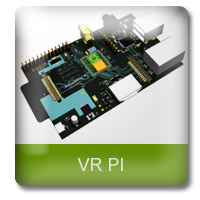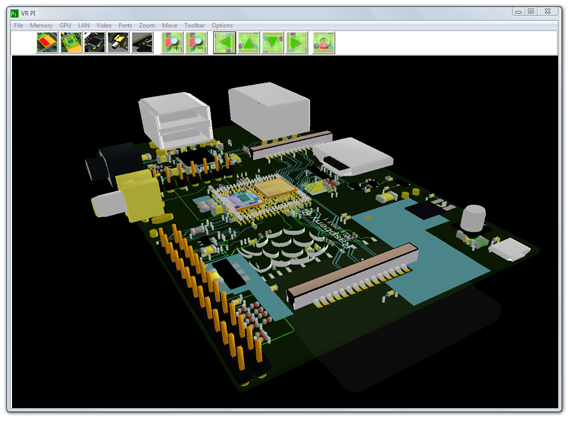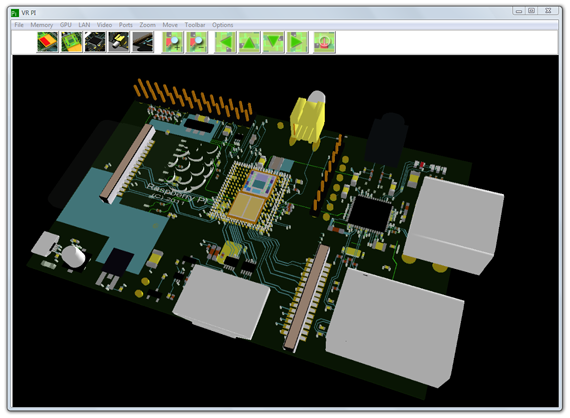VR PI
Simulates a raspberry pi

Camboard Technology
Computer science software for k12 and ks3 computing curriculum..
Key Features

Simulates a Raspberry Pi
The program is a great introduction to the inner workings of a Raspberry Pi. Students can see what is going on inside a virtual Raspberry Pi. VR PI simulates the main processes of a working virtual Raspberry Pi. The Raspberry Pi main systems are simulated in 3D. The Pi can be zoomed in and viewed from different angles. VR PI is a powerful simulation of the main processes involved in running applications and using hardware on a Raspberry Pi. VR PI shows the main processes of the GPU in block schematic form.
Memory
Local
GPU to CPU Memory port
Read
Simulates memory data being read from GPU memory port to CPU.
CPU to GPU Memory port
Write
Simulates memory data being written from CPU to GPU memory port.
CPU write to memory
Simulates memory data being written from CPU to GPU memory port. Shows data travelling through package on package pcb to memory chip.
CPU read from memory
Data is read from the onboard memory. Shows data travelling through package on package (PoP) pcb from memory chip.
Simulates memory data being read from GPU memory port to CPU.

SDIO
Write data from CPU to GPU SDIO port
Data is sent from CPU down bus to the SDIO port.
Read data from GPU SDIO port to CPU
Data is read from the SD card. Data then moves through the pcb to the SDIO port on the GPU.
Data is sent from SDIO port down bus to the CPU.
CPU to SD Memory Card Write data
Data is sent from CPU down bus to the SDIO port. Data then moves through the pcb to the SD card.
SD Memory Card Read data to CPU
Data is sent from SDIO port down bus to the CPU.

GPU
Ports
CPU to LAN
Data travels from CPU to LAN port on GPU.
CPU to Audio
Digital data is processed by the CPU it travels to the Audio port where it’s converted into an analogue signal.
CSI to CPU
Data is transferred from the CSI port to CPU.
CPU to DSI
Digital data is processed by the CPU it travels to the DSI port. The DSI port is typically used for driving small screens like a LCD.
CPU to GPIO
Digital data is processed by the CPU it travels to the GPIO port.
In reality data travels in both directions depending on whether an input or output device are connected through an external buffer board to the GPIO connector.
CPU to SPI
Digital data is processed by the CPU it travels to the SPI port. This port is part of the GPIO.
CPU to UART
Digital data is processed by the CPU it travels to the UART port. This port is part of the GPIO.
CPU to I2C
Digital data is processed by the CPU it travels to the I2C port. This port is part of the GPIO.
Graphics & Memory
CPU to Graphics
Digital data is processed by the CPU it travels to the Graphics port where OpenGL graphics are supported. The data is processed and converted into a graphics stream.
CPU to RCA
Digital data is processed by the CPU it travels to the Graphics port where it’s converted into a PAL stream ready to be transferred to the RCA socket.
CPU to HDMI
Digital data is processed by the CPU it travels to the Graphics port where it’s converted into a HDMI data format ready to be transferred to the HDMI socket.
CPU to SDIO
The SDIO port connects the CPU to a memory card that slots into the SD connector on the underside of the Pi. Data is transferred from the CPU to the SDIO port in the GPU.
CPU to Memory
Data is transferred from the CPU to the Memory port in the GPU
LAN
Ethernet (Data Out)
Data is processed by the CPU it travels to the LAN port. From here data travels through the pcb to the LAN chip. The LAN chip processes data and sends it to the Ethernet socket on the edge of the circuit board.
Ethernet (Data In)
Data is received at the Ethernet socket. Data moves to the LAN chip where it's processed. Data is moved through the circuit board to the LAN port on the GPU. Data is moved through the GPU bus into the CPU.
USB Typically used for connecting a mouse and keyboard and other external devices to the pi.
USB (Data Out)
Data is processed by the CPU it travels to the LAN port. From here data travels through the pcb to the LAN chip. The LAN chip processes data and sends it to the USB socket on the edge of the circuit board.
USB (Data In)
Data is received at the USB socket. Data moves to the LAN chip where it's processed. Data is moved through the circuit board to the LAN port on the GPU. Data is moved through the GPU bus into the CPU.
Graphics
CPU to RCA
Digital data is processed by the CPU it travels to the Graphics RCA port where it’s converted into a video signal.
CPU to HDMI
Digital data is processed by the CPU it travels to the Graphics HDMI port where it’s converted into a video signal.
CPU to RCA socket
Digital data is processed by the CPU it travels to the Graphics RCA port where it’s converted into a video signal. Data is then routed to the RCA socket.
CPU to HDMI Socket
Digital data is processed by the CPU it travels to the Graphics HDMI port where it’s converted into a video signal. Data is then routed to the HDMI socket.
Ports
Audio
CPU to Audio
Digital data is processed by the CPU it travels to the Audio port where it’s converted into an analogue signal.
CPU to Audio Socket
Simulates digital data being converted into an analogue signal which is fed to the audio socket.
CSI DSI
CSI Connector to CPU
Data is transferred from the CSI port to CPU. The CSI port is used for connecting a digital camera.
CPU to DSI Connector
Digital data is processed by the CPU it travels to the DSI port. The DSI port is typically used for driving small screens like a LCD.
GPIO
The GPIO input/output pins are situated on the top left hand side of the circuit board. These enable input output devices to communicate with the pi.
CPU to I2C Connector
Transfers data between the I2C connectors on the GPIO to the CPU.
CPU to SPI Connector
Transfers data between the SPI connectors on the GPIO to the CPU.
CPU to UART Connector
Transfers data between the UART connectors on the GPIO to the CPU.
System Requirements
Requires a PC or laptop
With Windows XP/VISTA/7/8/10 and DirectX 8.1 or higher.